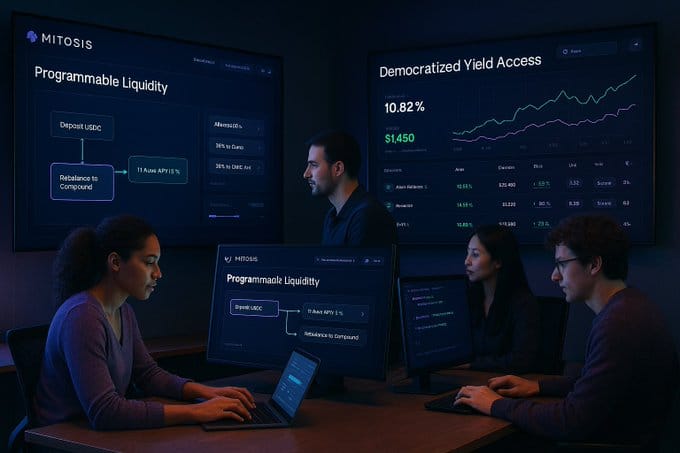The Vanilla Assets 2

When users deposit assets into Mitosis Vaults across various blockchain networks, they receive Vanilla Assets on the Mitosis Chain as representations of their deposits. These Vanilla Assets act as stable and reliable representations that make it easier to manage and interact with assets on the Mitosis Chain. They can be allocated to yield-generating opportunities through two distinct frameworks: Ecosystem-Owned Liquidity (EOL) or Matrix.

INTRODUCTION
EOL facilitates the collective management of pooled assets through democratic governance. This governance model empowers participants by allowing them to vote on allocation strategies, thereby giving them a direct influence on how the pooled liquidity is deployed. This model is ideal for communities that value transparency and collaborative decision-making. In contrast, the Matrix framework is designed for users who want a more direct and predefined engagement. Matrix enables participation in curated liquidity campaigns with specific, predefined terms that are tailored to various DeFi strategies.
Both frameworks issue specialized tokens that represent users' positions in the ecosystem. For users participating in the EOL framework, they receive miAssets, while those engaging with Matrix receive maAssets. These specialized tokens not only symbolize the ownership of the underlying assets but also come with additional functionalities and utilities that make them more than just passive representations.
maAssets are liquid, yield-bearing tokens that are issued within Mitosis Matrix Vaults. These tokens represent a liquidity provider’s staked position and entitlements within the Mitosis ecosystem. They are designed to empower participants by allowing them to earn rewards, maintain high levels of liquidity, and improve their capital efficiency. By holding maAssets, users are able to actively contribute to decentralized finance (DeFi) protocols within the Mitosis ecosystem without sacrificing access to their capital.
Unlike traditional liquidity pool tokens, maAssets feature programmable liquidity. This means that liquidity providers are not limited to fixed strategies or manual processes. Instead, they can participate in customized staking campaigns, take part in governance decisions, and execute cross-chain liquidity strategies without the need for complex manual reallocation.
maAssets Functionality Liquidity Contribution – Users can deposit ETH, stablecoins, or a variety of other supported assets into Matrix Vaults. In return, they receive maAssets that act as tokenized representations of their deposits. These tokens can then be used across a variety of DeFi applications.
Yield Generation – maAssets continuously accumulate rewards from multiple sources. These include staking incentives provided by protocols, rewards from governance-based decisions, and other ecosystem incentives. This continuous yield generation ensures that users are rewarded over time for their participation.
DeFi Utility – maAssets are highly versatile and can be leveraged for a wide array of DeFi use cases. These include:
- Lending and borrowing in decentralized money markets
- Yield farming strategies to earn additional incentives
- Liquidity provision in Automated Market Makers (AMMs) and cross-chain liquidity pools
Governance Participation – maAsset holders are not just passive investors. They can actively participate in governance processes to influence how liquidity is allocated and how incentives are structured within the ecosystem. This participatory model helps align incentives between users and the protocol.
Redemption and Exit – At the conclusion of a staking campaign, users can redeem their maAssets for the original deposited assets, along with any rewards accumulated during the staking period. This ensures a transparent and fair exit process.
Key Features Automated Yield Generation – maAssets continuously accumulate rewards from staking and DeFi activities without requiring manual intervention.
Flexible Liquidity Allocation – Thanks to programmable liquidity, users can deploy their maAssets across various DeFi protocols without needing to constantly manage or reallocate them.
Cross-Chain Compatibility – maAssets support liquidity movement across Ethereum, Layer 2 networks, and other modular blockchains. This ensures that users can maximize their capital efficiency by engaging with the most lucrative opportunities available across multiple ecosystems.
Governance-Driven Utility – maAsset holders can vote on how liquidity is distributed and how incentives are structured, giving them a direct role in shaping the direction of the protocol.
Benefits of maAssets
◼ Automated Yield Generation – Earn layered rewards from various DeFi protocols effortlessly, without the need for active staking management.
◼ Optimized Cross-Chain Liquidity – Maximize capital efficiency by seamlessly deploying assets across different blockchain networks.
◼ Seamless DeFi Integration – Utilize maAssets as collateral in lending platforms, AMMs, and yield farming opportunities.
◼ Governance Power – Actively participate in liquidity campaign decisions to help optimize community rewards.
Use and Real-World Application of maAssets
Automated Yield Optimization – For instance, users can deposit ETH into Mitosis Vaults and receive maETH. These maETH tokens can then be deployed into various DeFi protocols that support maAssets, allowing users to earn native staking rewards along with other DeFi incentives.
Multi-Chain Yield Farming – The programmable nature of maAssets allows them to be distributed across multiple blockchains. This means users can tap into the best staking and liquidity farming opportunities regardless of the chain they are most active on.
Governance-Directed Liquidity – One of the most powerful features of maAssets is their ability to be directed through community governance. Token holders can vote on proposals that influence where liquidity is allocated, helping to maximize yields and minimize risks across the ecosystem.
Advanced Capital Efficiency – Unlike traditional staking, where assets are locked and unusable, maAssets allow users to remain liquid. This means they can continue to interact with other DeFi platforms while earning passive income from their maAsset holdings.
Institutional and Retail Use Cases – maAssets are designed to appeal to both institutional and retail users. Institutions can use them for complex liquidity strategies across chains, while retail users benefit from simple, automated yield farming with governance rights.
Conclusion
maAssets serve as a vital component of the Mitosis ecosystem, offering liquid, yield-bearing opportunities that significantly enhance capital efficiency while maintaining flexibility across various blockchain networks. By integrating programmable liquidity, maAssets allow users to engage seamlessly in staking, governance, and cross-chain liquidity strategies. This eliminates the need for constant manual management and opens the door for more sophisticated, automated DeFi strategies.
Through features like automated yield generation, cross-chain compatibility, and governance-driven utility, maAssets provide liquidity providers with a dynamic, efficient tool to maximize rewards and influence protocol direction. Whether utilized for DeFi lending, yield farming, or governance participation, maAssets ensure that users remain liquid, incentivized, and strategically positioned in a fast-evolving decentralized financial ecosystem.
To learn more, kindly log on to university.mitosis.org



Comments ()